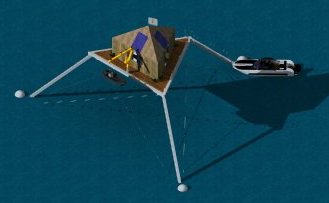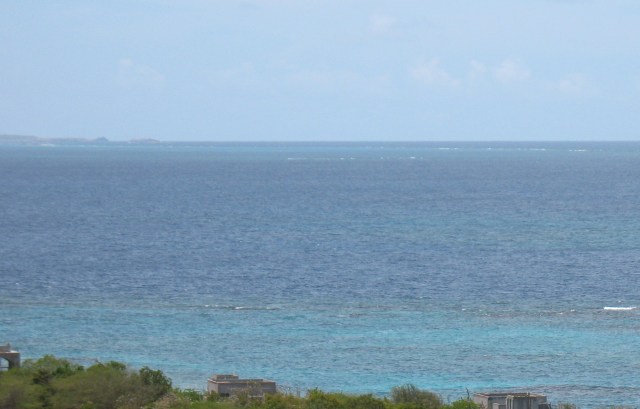User:Vincecate/FloatingVilla
Rental houses in Anguilla are called villas. This proposal is to make money renting out early seastead prototypes off the coast of Anguilla. After we get a few seasteads operational, it could be called a "seastead resort". It is a bit like overwater bungalows in Tahiti but floating instead of on columns. I made a video on this idea for Seasteading 2009 conference.
<youtube v="p4icNUDqNIg" />
Contents
Taxes
In Anguilla there is no income tax or sales tax. However, there is a "hotel tax" or "visitor tax", officially covered in the "transient persons act". Basically there is a 10% tax on any room rented by the day or week.
Stabilizers
There is a boat stabilizer for while at anchor. We could put one of these below each of the 3 corners. It would resist being lifted up by the float and dampen out oscillations. With this using a spar shaped float would work well.
Non-stretch Rope
The Dynex Dux rope is strong and has minimal stretch. This would work well for the ropes in the structure.
Financial Estimates
This is probably around $100,000 US and should rent for about $1,000/week. If we rent even 10 weeks per year it should be a reasonable investment.
I plan to get an engineer to spec out the aluminum parts and then get prices for those parts and an estimate for the welding. So should get a better estimate of the cost.
Licenses and regulations
Would need a "business license", but this is not usually hard to get, particularly for a local.
A foreigner working in Anguilla would need a "work permit". The support work is best done by locals. By this I mean maid service, maintenance, water taxi, etc. If people came down to assemble a seastead and were not getting paid (strictly volunteer) there should not be any problem.
If I build something and play with it, people in Anguilla probably won't care. However, a seastead would need a "boat license" if it has a motor and tourists were going to go on it. Could start without a motor and maybe not rent to the public. A boat license takes certification by some place outside Anguilla. At NMMA, the first place I checked, this certification would cost about $2,500 plus travel costs. So this is probably affordable, though it may be more than this as this design will be very different than what they are used to certifying. The seastead would probably be classified as a "house boat". We might need to test it for a year or something for people to get comfortable with the design. It may not be reasonable to expect to have paying customers on what is really an experimental prototype. Or maybe engineering, CAD design, and simulation is advanced enough these days that this is reasonable.
I sent the NMMA people a link to my tension circle page to check if they could certify such a thing as a boat. Their answer was if it had propulsion and/or the US Coast Guard would issue me an MIC (Manufacturers Identification Code) designated for boat builders then they could. I could get an MIC code or have someone with one build the vessel. We should understand how to use large low RPM propellers for efficient movement at slow speeds, so putting an engine on is something we need to do sometime anyway. Even with kites for open ocean, I think we need engines for harbors.
If it does not have motors/engines/sales/kites but is just a floating house it is not clear what it needs.
If it was lifting a boat out of the water, we could just call it a "stabilizer" for the boat. Since the boat is already licensed we probably don't have legal troubles.
First Location
The location I like is a nice spot north of Anguilla. It is on the downwind side of the island and inside a reef while a few miles offshore. So it is sort of out in the ocean but sort of protected so the waves are not too bad. Here is a chart showing that the dark blue area in the first link just inside the reef is about 20 meters deep. It is far enough that people won't notice it much. It is almost an "out of sight is out of mind" situation. If you are paying 10% to the government and not bothering anybody I don't think there would be any trouble. It is also not far from my dome and within line-of-sight from a building I have on the top of our hill. So about 3 miles offshore, 4 miles from a good harbor, and around 5 miles from my property (picture above is from my property). Another nice thing about this location is there is a water taxi based in the nearby harbor. The view is wonderful, the wind is nice, the reef amazing, the water clear, and not many people around. I think it is a location people would love to spend time at.
Tourist activity
Going the 4 miles to the harbor could take 10 to 20 minutes one way. It would be nice if there was entertainment near the seastead. Be good if people could have enough fun things to do that they could stay by the villa most of the week. Some possibilities are:
- Amphibious ATV or some Amphibious Jeep for playing on water and land
- scuba diving
- snorkeling
- sailing
- kayaks
- kite surfing
- practice kite powered life raft evacuation to downwind island
- power boats (jet-skis not allowed in Anguilla)
- glass bottom boat (guy here in Anguilla could pick them up at seastead)
- fishing from seastead or boat
- operating an ROV - maybe catching lobster by remote control
- restaurant/bar/food delivery
- lobster traps
- internet (wireless providers and line-of-site to my place)
- phone (cell phone is easy, as is Internet phone)
Anguilla has a hotel named "Cuisinart" that has a hydroponic greenhouse. Tourists find the tour of the greenhouse very interesting. A similar thing could be done with the seasteads. Perhaps a combination of a micro-version of the Eden project and the floating greenhouses developed by Dutch firm Dura Vermeer? Fish farming could be fun. Anything we were experimenting with, testing, developing could be of interest to someone who picked this vacation spot.
Baby steps
This a relatively easy first step that should be profitable. Being close to land avoids the problems of communication and transportation. At this distance the regular cell towers work and there is wireless Internet. A good harbor being 4 miles away makes getting people and cargo there easy. The island has an airport so people can come from all over.
This lets us test out prototypes and make money from them. If we can make money off our R&D efforts, then the capital investment needed is much smaller.
Future Versions
Could make versions with Big Efficient Propellers so it could move around slowly. Could make larger versions. Could test for deep ocean waves.
Over time we can put seasteads outside the reef and further and further out. If there is a storm coming we could bring the seasteads back inside the reef (maybe leave an empty one out in the storm for testing). Eventually we would have a group of seasteads that we trusted enough to go out into the open ocean.
If we want to take tourists on Migration routes we will need licensed boats to go to the islands. So going through the license procedure is something we will need to do anyway.
So this is an incremental plan that makes money along the way and eventually gets to our goal of seasteads out in the open ocean.

